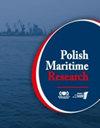Influence of Material Thickness on the Ductile Fracture of Steel Plates for Shipbuilding
IF 2
3区 工程技术
Q2 ENGINEERING, MARINE
引用次数: 0
Abstract
Abstract In the shipbuilding industry, the risk of brittle fractures is relatively high because some units operate in arctic or subarctic zones and use high thickness (up to 100 mm) steel plates in their structures. This risk is limited by employing certified materials with a specific impact strength, determined using the Charpy method (for a given design temperature) and by exercising control over the welding processes (technology qualification, production supervision, and non-destructive tests). However, for offshore constructions, such requirements may prove insufficient. For this reason, regulations employed in constructing offshore structures require conducting crack tip opening displacement (CTOD) tests for steel and welded joints with thicknesses exceeding 40 mm for high tensile strength steel and 50 mm for other steel types. Since classification codes do not accept the results of CTOD tests conducted on specimens of sub-sized dimensions, the problem of theoretically modelling the steel construction destruction process is of key importance, as laboratory tests for notched elements of considerable thickness (100 mm and higher) are costly and problems stemming from high loads and a wide range of recorded parameters are not uncommon. The aim of this research is to find a relationship between material thickness and CTOD value, by establishing and verifying a numerical model that allows recalculating a result obtained on a sub-size specimen to a full- size specimen for a ductile fracture mode. This work presents results and conclusions from numerical modelling and compares them with laboratory test results of the elastic-plastic properties of high thickness steel, typically used in offshore applications.材料厚度对造船用钢板韧性断裂的影响
在造船业中,脆性断裂的风险相对较高,因为一些单位在北极或亚北极地区作业,并在其结构中使用高厚度(高达100毫米)钢板。通过采用具有特定冲击强度的认证材料(使用Charpy方法确定(给定设计温度))以及通过对焊接过程(技术鉴定、生产监督和无损检测)进行控制,可以限制这种风险。然而,对于近海建筑来说,这样的要求可能是不够的。因此,在建造海上结构时所采用的法规要求对钢和焊接接头进行裂纹尖端张开位移(CTOD)测试,高抗拉强度钢的厚度超过40毫米,其他钢类型的厚度超过50毫米。由于分类规范不接受对亚尺寸试件进行的CTOD试验的结果,因此对钢结构破坏过程进行理论建模的问题至关重要,因为对相当厚(100毫米及以上)的缺口构件进行实验室试验成本高昂,而且由于高载荷和记录参数范围广泛而产生的问题并不罕见。本研究的目的是通过建立和验证一个数值模型来发现材料厚度与CTOD值之间的关系,该模型允许将在亚尺寸试件上获得的结果重新计算到塑性断裂模式的全尺寸试件上。这项工作提出了数值模拟的结果和结论,并将其与高厚度钢弹塑性性能的实验室测试结果进行了比较,高厚度钢通常用于海上应用。
本文章由计算机程序翻译,如有差异,请以英文原文为准。
求助全文
约1分钟内获得全文
求助全文
来源期刊

Polish Maritime Research
工程技术-工程:海洋
CiteScore
3.70
自引率
45.00%
发文量
20
审稿时长
>12 weeks
期刊介绍:
The scope of the journal covers selected issues related to all phases of product lifecycle and corresponding technologies for offshore floating and fixed structures and their components.
All researchers are invited to submit their original papers for peer review and publications related to methods of the design; production and manufacturing; maintenance and operational processes of such technical items as:
all types of vessels and their equipment,
fixed and floating offshore units and their components,
autonomous underwater vehicle (AUV) and remotely operated vehicle (ROV).
We welcome submissions from these fields in the following technical topics:
ship hydrodynamics: buoyancy and stability; ship resistance and propulsion, etc.,
structural integrity of ship and offshore unit structures: materials; welding; fatigue and fracture, etc.,
marine equipment: ship and offshore unit power plants: overboarding equipment; etc.
 求助内容:
求助内容: 应助结果提醒方式:
应助结果提醒方式:


